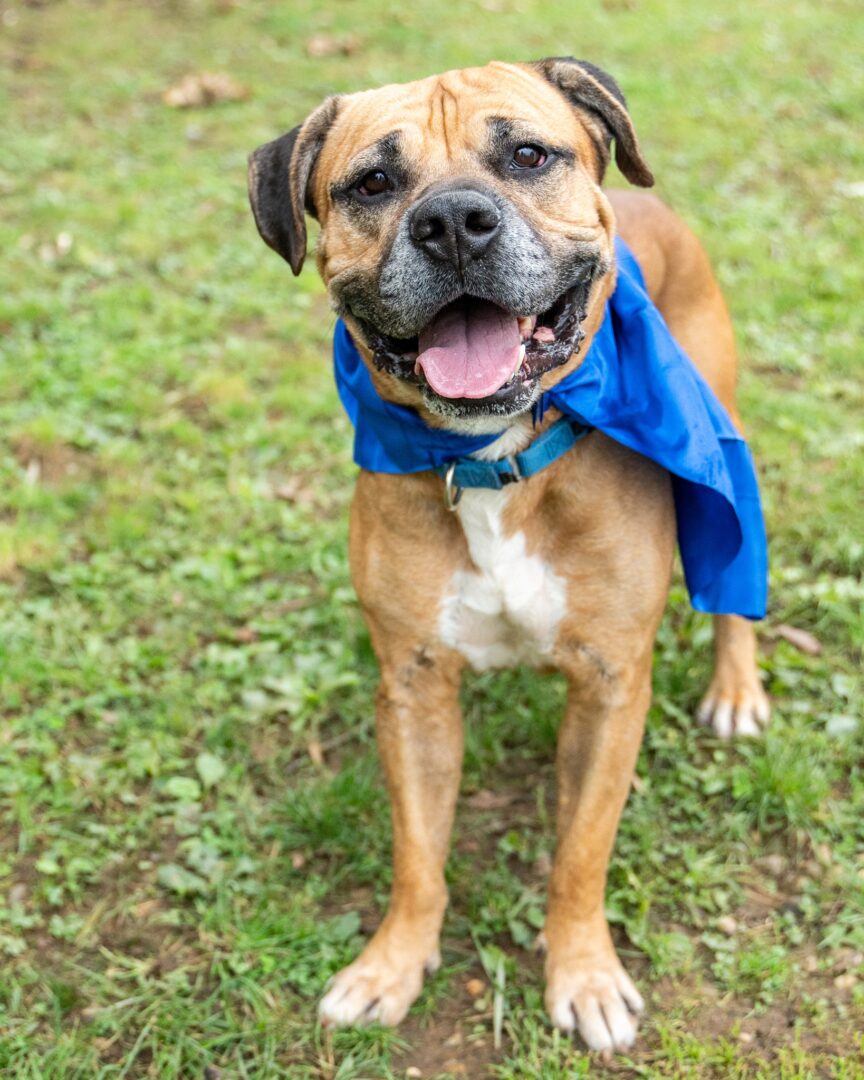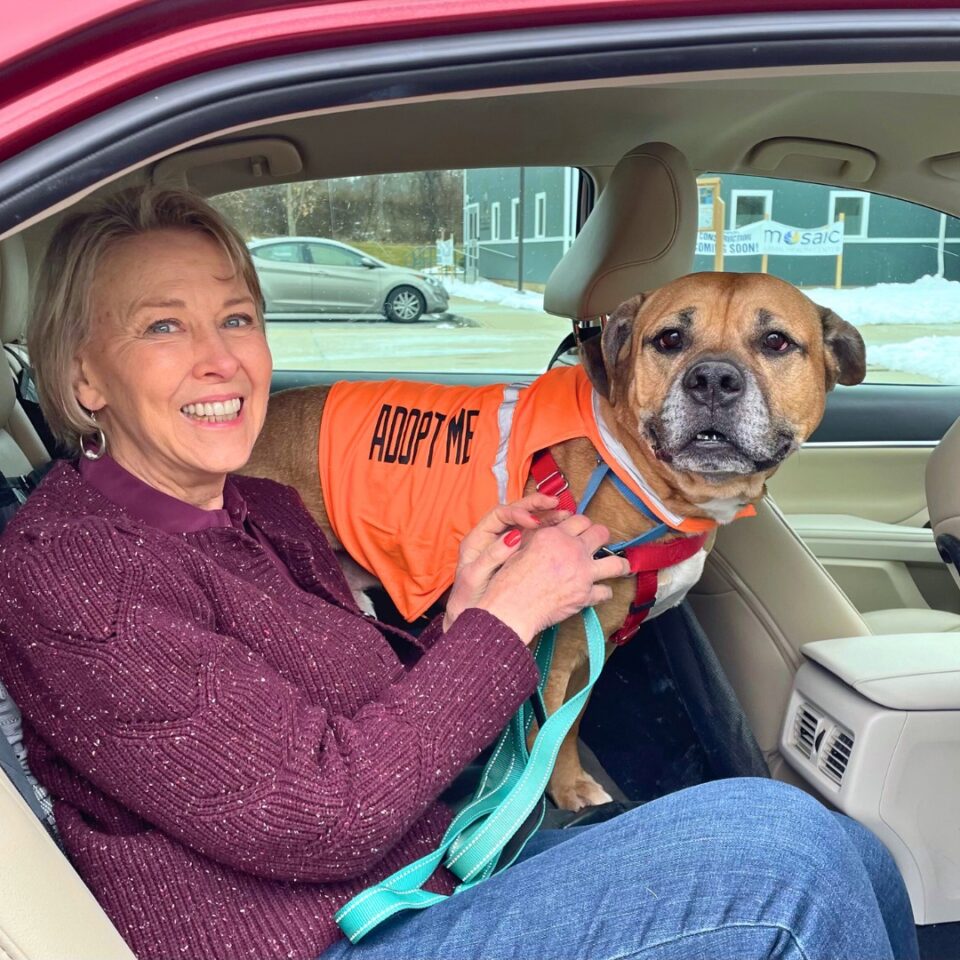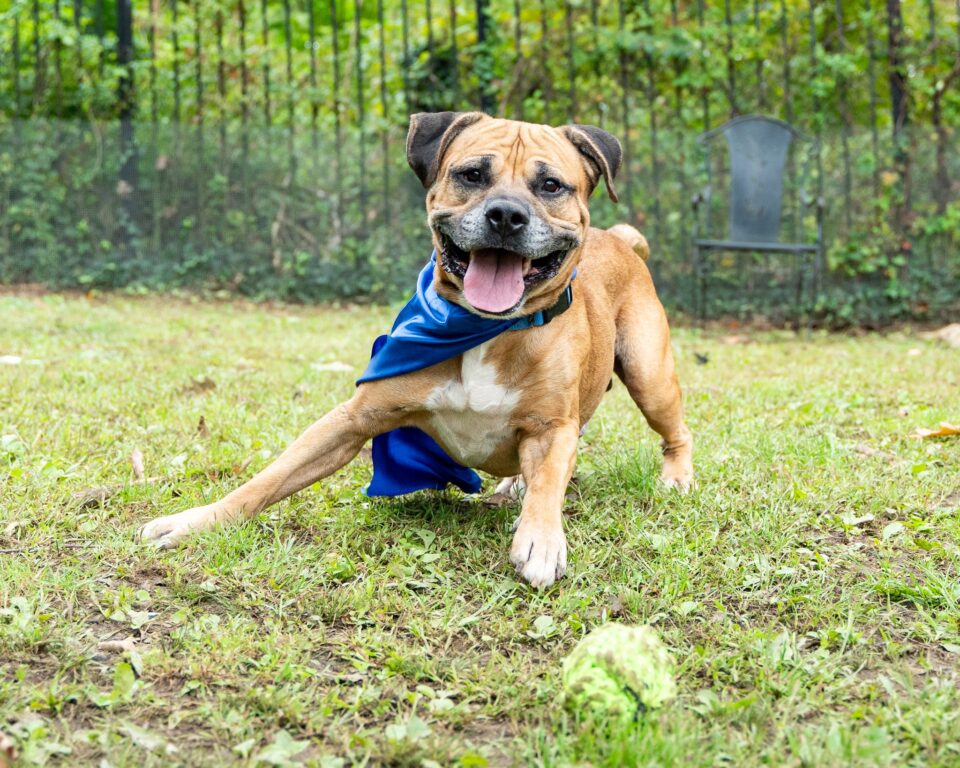Original Good Boy, or OGB for short, was an eight-year-old pup who was surrendered to the Humane Rescue Alliance in Washington, DC, before being transferred to St Hubert’s Animal Welfare Center in New Jersey.
He spent his days in the New Jersey shelter, hoping that a loving hooman would take him into a loving home. Unfortunately, time went by, and nobody noticed this sweet boy.
OGB started losing hope, but then everything changed when he met her!
One Interesting Pup
When a 70-year-old woman named Susan Wright visited the New Jersey shelter just before Christmas, she did not plan to fall in love with a senior pup.
“We were walking around looking at the fur babies when I noticed one dog had his back to the door ignoring all attempts to engage him,” Wright told Newsweek.
Wright also added that initially, she didn’t really think that OGB looked particularly ‘cute’ as he had the face of a very serious dog with “a square head of a bulldog and the compact muscular body of a terrier or pit bull”.
 Source: St. Hubert’s Animal Welfare Center
Source: St. Hubert’s Animal Welfare Center
As soon as the shelter staff met this incredible boy, they knew they were going to have a lot of fun with him.
“He couldn’t get enough love, belly rubs, and scratches. And when he gets really pleased, he does an adorable little ‘happy dance’,” St Hubert’s staff member Diane Ashton told Newsweek.
Ashton explained that compared to the shelter’s other dogs, OGB was quieter and much more reserved in his kennel, which may be the reason why he wasn’t immediately noticed by potential adopters.
But, when Wright met OGB, she decided to take him out on little field trips that included walking around the neighborhood, playing in the park, and going out for puppacinos!
“We had a slightly rocky start as I knew nothing about how to walk a dog, especially a strong dog. OGB wouldn’t look at me or listen to me. I noticed he did not ‘see’ women, but men he paid very close attention to ands particularly those in a large SUV or truck. He also didn’t react to children,” Wright said.
But, when Wright understood that OGB’s previous owner was most likely a male who regularly ran or jogged, she decided to hire a trainer to help the two of them get to know each other a bit better.
This incredible plan worked like a charm, helping them create a strong bond between them.
“When my daughters discovered what I was doing, they wanted to go on a walk with OGB. They loved him on sight and thought he was quite handsome. It felt a little like introducing a date to them,” Wright said.
New Chapter In Life
One day, Wright received information that somebody was interested in adopting OGB. It was at this moment that she realized that she was unable to say goodbye to this sweet boy.
That is why she decided to adopt him!
OGB, who now goes by Ogee, is finally a part of a loving family.
He immediately settled into his new home and even started to show off his loving and gentle nature.
Wright shared one instance where, as her daughter was taking him on a walk, they came across a little boy who fell off his bike and injured his wrist.
When Wright’s daughter called the boy’s mother, Ogee lay between her legs allowing the boy to pet him as he gently licked his injured wrist.
“Would all dogs do that, I don’t know. But we think it makes Ogee very special,” Wright stated.
It is so heartwarming to see just how big of an impact a forever home can make on a pup’s life.
He loves spending his days with his new family, showering them with love and adoration with every passing second!
Ever wondered about the age-old question of how time translates for our beloved canine companions? Understanding the age equivalency between humans and dogs can provide fascinating insights into our furry friends’ life stages. When it comes to the concept of dog years, things aren’t always as straightforward as they seem.
As a seasoned dog enthusiast, you’re likely aware that the aging process in dogs differs from that of humans. The idea of dog years is a popular way to estimate your pup’s age relative to a human’s, but the calculation involves more than just a simple one-to-one conversion. So, how does the age of 3 translate in dog years? Let’s embark on a journey to uncover the mysteries behind this intriguing topic.
Understanding Dog Years
Let’s get the bark on understanding dog years! It’s common knowledge that dogs age faster than humans. While a 1-year-old dog is roughly equivalent to a 15-year-old human, the aging process varies throughout a dog’s life.
Age 3 in Dog Years
At 3 dog years, your furry friend is akin to a young adult. This is when most dogs reach physical and mental maturity. In dog years, a 3-year-old pooch is about 28 in human years. So, your dog’s adolescence is behind them, and they’re now ready to embrace adulthood.
The Aging Process
As dogs age, the concept of dog years becomes more pertinent. Small breeds tend to live longer than larger breeds, so their aging process differs. While age 3 might mark adulthood for many dogs, it’s important to consider that large breeds may still be considered adolescents at this stage.
Health Considerations
Just like humans, dogs’ health needs may change as they grow older. Regular vet check-ups, a balanced diet, and proper exercise are essential for maintaining your dog’s well-being. Age 3 is a crucial time to establish these routines for your furry companion’s long-term health.
Wrapping Up
Understanding dog years sheds light on your canine companion’s life stages. Age 3 in dog years signifies a shift from adolescence to adulthood, highlighting the importance of tailored care and attention to ensure a happy and healthy journey with your beloved pet.
Calculating Age in Dog Years
To calculate a dog’s age in dog years, it’s essential to understand the general rule used by veterinarians and dog experts to estimate the equivalent age of a dog compared to a human’s age. Here’s a straightforward way to calculate it:
Step 1: Understanding the 1:7 Rule
- The commonly accepted rule to convert dog years to human years is multiplying a dog’s age by 7. This rule offers a rough estimate, especially for younger dogs.
Step 2: Adjusting the Calculation by Age
- For the first year of a dog’s life, you can consider them to age by about 15 human years, as they undergo rapid growth and development.
- From the second year onward, the 1:7 rule can be used to estimate their age in human terms. For instance, a 3-year-old dog would be approximately 21 in human years.
- Keep in mind that the size and breed of a dog play a significant role in determining their aging process. Small breeds tend to live longer than larger breeds.
- Larger dogs age more quickly in their early years but tend to have shorter lifespans than smaller dogs due to various factors like genetics and health concerns.
By following these simple steps and understanding the 1:7 rule, you can easily calculate your dog’s age in “dog years” and gain a better perspective on their life stage and needs.
Common Misconceptions
Conclusion
So, now you know how to calculate your furry friend’s age in dog years. Remember, at 3 years old, your dog has reached both physical and mental maturity. Using the 1:7 rule can give you a rough estimate, but keep in mind that size and breed play a significant role in how dogs age. Understanding these calculations can guide you in providing the best care for your canine companion as they grow older. By debunking common misconceptions about dog years, you can gain a clearer picture of where your dog is in their life stage and cater to their specific needs accordingly. Stay informed, and keep your pup happy and healthy throughout their journey with you!
Frequently Asked Questions
How do dogs age compared to humans?
Dogs age faster than humans due to their shorter lifespan and faster development. One common method to calculate a dog’s age in “dog years” is by using the 1:7 rule, where a dog’s age is multiplied by 7 to estimate their age in human years.
At what age do dogs reach physical and mental maturity?
Dogs typically reach physical and mental maturity around the age of 3. This is when they are considered fully grown and have developed their adult personalities and behaviors.
How does a dog’s size and breed affect the aging process?
Size and breed play a significant role in how dogs age. Smaller breeds tend to live longer than larger breeds, and different breeds may age at varying rates. Tailored health care is essential for addressing the specific needs of different sizes and breeds as they age.
What are some common misconceptions about dog years?
One common misconception is that all dogs age at the same rate, which is not true. The 1:7 rule is a rough estimate and may not apply universally. Another misconception is that 1 human year is equivalent to 7 dog years throughout a dog’s life, which is inaccurate and oversimplified. Understanding the nuances of canine aging can help owners make informed decisions about their dog’s care.
[no_toc]

Hey there, I’m Janet Brooks, a dog-loving student from California. I’m all about helping pups in need, especially those without homes. Me and my awesome friends work together to give shelter and love to stray dogs. Oh, and I also write blogs about dogs to share helpful info.
 Source:
Source:  Source:
Source:  Source:
Source: